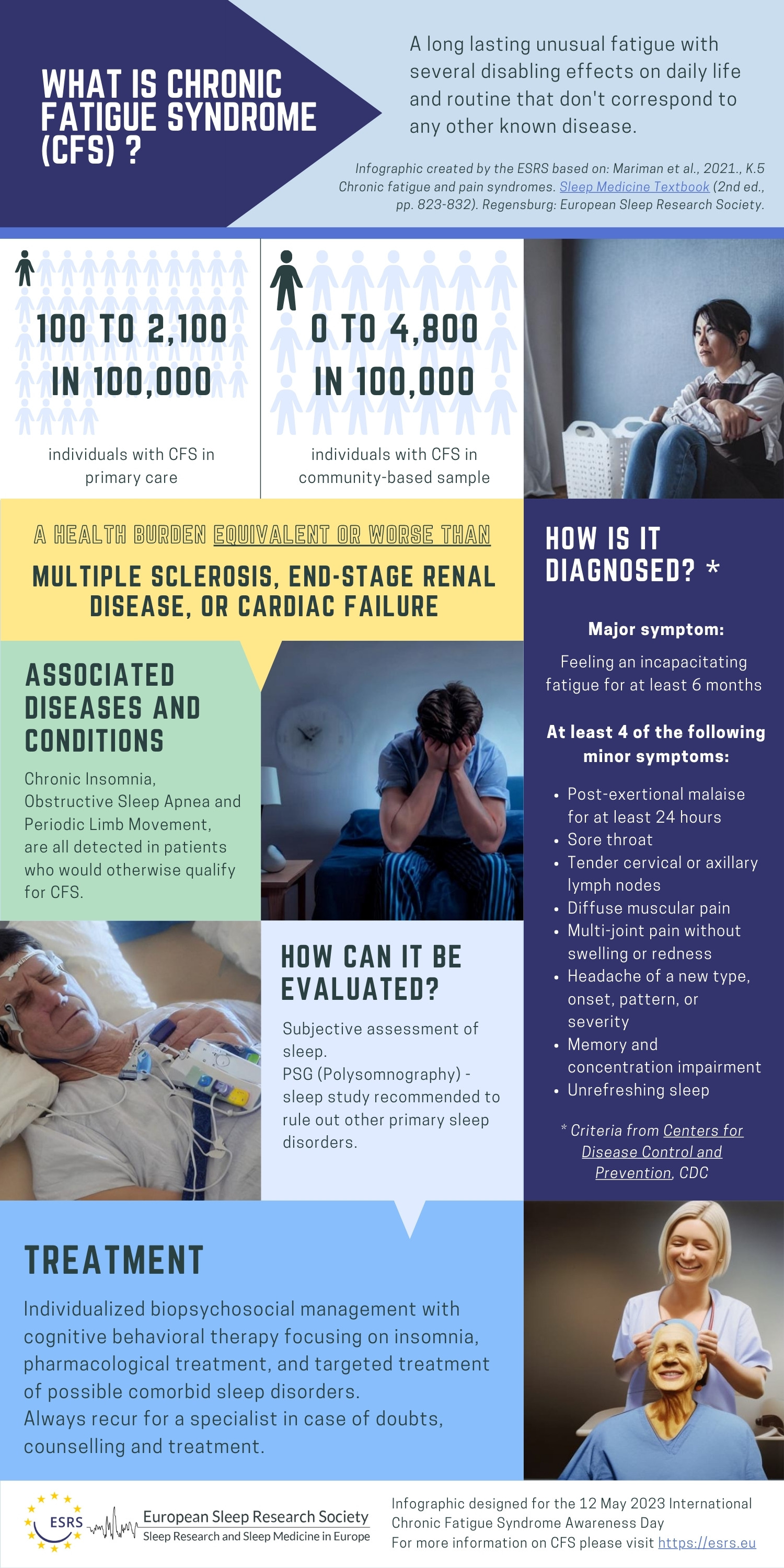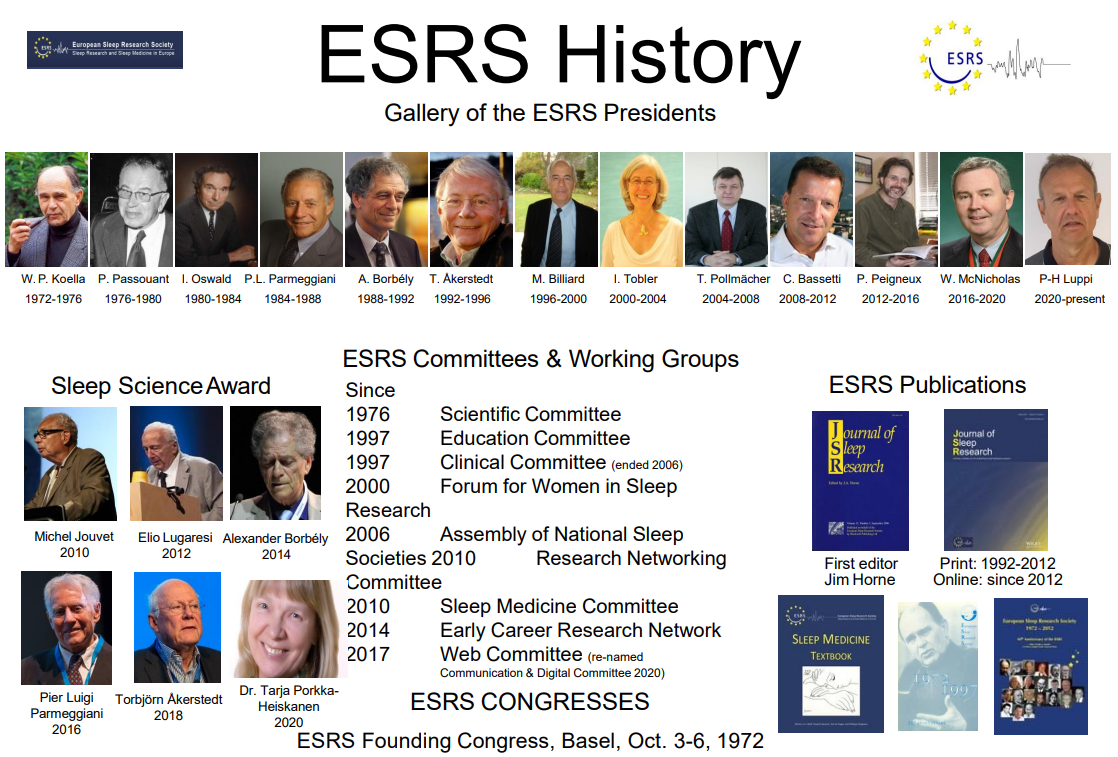12 May – International Chronic Fatigue Syndrome Awareness Day
Today, the 12th of May, is the Myalgic Encephalomyelitis /Chronic Fatigue Syndrome (ME/CFS) International Awareness Day. It aims to raise public awareness of the importance and life (and economic) impacts of ME/CFS, to educate about the symptoms and treatment, and advocate for increased research funding.
The 12 May also honors the birthday of Florence Nightingale, considered the founder of modern nursing, having established the Nightingale Training School for Nurses in 1860 as part of her efforts to improve hygiene practices.
To highlight the importance of this day, the ESRS is pleased to share some key facts and figures of Chronic Fatigue Syndrome in the following article and an infographic you can find below, especially designed for the International Chronic Fatigue Syndrome Awareness Day. The following information was based on the ESRS Sleep Medicine Textbook chapter Chronic Fatigue and Pain Syndromes (Mariman et al. 2021).
Keywords:
chronic fatigue syndrome (CFS), chronic pain, dysfunction, fibromyalgia, medically unexplained symthomes, non-restorative sleep
Chronic fatigue Syndrome (CFS)
Chronic fatigue Syndrome is characterized by long lasting abnormal fatigue that is not relieved by rest, with disabling effects on professional, social, and daily functioning in the absence of any nosologically defined disease that would sufficiently explain symptoms.
Diagnostic criteria
From Centers for Disease Control and Prevention, CDC
A. Major criterium of new incapacitating fatigue for at least 6 months
B. At least four of the following minor criteria: post-exertional malaise for at least 24hrs (post-exertional malaise or PEM, is the worsening of symptoms after physical or mental activity); sore throat; tender cervical or axillary lymph nodes; diffuse muscular pain; multi-joint pain without swelling or redness; headache of a new type, onset, pattern, or severity; memory and concentration impairment; unrefreshing sleep.
Prevalence
100 – 2,100 per 100,000 in primary care.
0 – 4,800 per 100,000 in community-based samples.
Burden
CFS has a health burden equivalent or worse than serious chronic diseases such as multiple sclerosis, end-stage renal disease or cardiac failure.
Underlying mechanisms
The absence of any clear pathophysiological substrate, biological marker or diagnostic test makes acceptance of CFS as a problematic specific illness. As such it is best conceptualized within a biopsychosocial framework of vulnerability, triggering and perpetuating factors. Onset may be related to a biological agent or trauma and chronicity may be determined by psychosocial factors such as maladaptive behavior, negative conditioning and the search for a socially accepted label of ‘medical illness’. Nevertheless, chronic conditions are often accompanied by ‘biological fingerprints’, such as central nervous system and autonomic system dysregulations. Patients with CFS usually have non-restorative sleep with a frequent pattern of insomnia. In addition to pure CFS, there are often co-morbid sleep and/or mood disorders.
Assessment
Apart from subjective assessment of sleep, PSG (Polysomnography) / sleep study is hence recommended to rule out other primary sleep disorders.
Comorbidities
Chronic insomnia, obstructive sleep apnea and periodic limb movement are all detected in patients who would otherwise qualify for CFS – not always clear if present as primary sleep disorder or comorbidities.
Treatment
Multimodal and individualized biopsychosocial management is recommended, including cognitive behavioral therapy focusing on insomnia, pharmacological treatment, and targeted treatment of comorbid sleep disorders, when required.
Infographic "What is Chronic Fatigue Syndrome?"

Download the Chronic Fatigue Syndrome Infographic in PDF format:
Article and CSF infographic based on:
Mariman et al. (2021)., K. Sleep and Internal Medicine 5. Chronic fatigue and pain syndromes. In Bassetti, C., McNicholas, W., Paunio, T., & Peigneux, P. (Eds.). Sleep Medicine Textbook (2nd ed., pp. 823-832). Regensburg: European Sleep Research Society.
Article written by:

Kate Porcheret
Postdoctoral Researcher at the Norwegian Center for Violence and Traumatic Stress Studies, Oslo, Norway and a member of the ESRS Digital and Communication Committee.

An Mariman
Professor at the University Hospital Ghent, Belgium, department of psychiatry and physical medicine and Rehabilitation, specializing in medically unexplained symptoms, particularly chronic fatigue, and sleep disorders. Contributor to the 2nd ed. of the Sleep Medicine Textbook.
Recent publications from ESRS members
- Kunz et al. (2023). Sleep and circadian rhythms in α-synucleinopathies-Perspectives for disease modification. Acta Physiol (Oxf).
- Ferri et al. (2023). Periodic leg movements during sleep associated with antidepressants: A meta-analysis. Neurosci Biobehav Rev.
- Kovalzon (2023). Cerebral information processing during sleep: evolutionary and ecological approaches. J. Evol. Biochem. Physiol.
- Åkerstedt et al. (2023). Insufficient sleep during adolescence and risk of multiple sclerosis: results from a Swedish case-control study. J Neurol Neurosurg Psychiatry.
- Ibrahim et al. (2023). Large Muscle Group Movements during Sleep in Healthy People: Normative Values and Correlation to Sleep Features. Sleep.
- Philip et al. (2023). The Bordeaux Sleepiness Scale (BOSS): a new questionnaire to measure sleep-related driving risk. J Clin Sleep Med.
- Huttunen et al. (2023). A Comparison of Signal Combinations for Deep Learning- Based Simultaneous Sleep Staging and Respiratory Event Detection. IEEE Trans Biomed Eng.
- Cistulli et al. (2023). Relationship between Self-Reported Sleepiness and Positive Airway Pressure Treatment Adherence in Obstructive Sleep Apnea. Ann Am Thorac Soc.
- Mogavero et al. (2023). Genetics and epigenetics of rare hypersomnia. Trends Genet.
- Basoglu, Tasbakan & Kayikcioglu (2023). Dyslipidemia prevalence in nonobese, nondiabetic patients with obstructive sleep apnea: does sex matter? J Clin Sleep Med.



